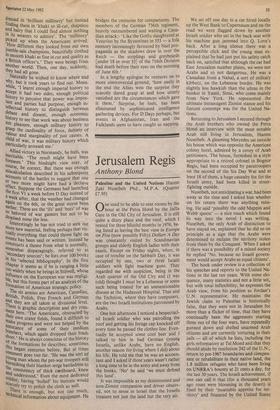Battlefields
Philip Warner
Six Armies in Normandy John Keegan (Cape £8.95) is almost impossible to find any topic which The battlefields of Normandy have been has not been worn threadbare. J01111 study groups and instructional tours that it the subject of so many books, lectures, Keegan must have been well aware of tins problem, for he has been a lecturer in military history for nearly 20 years and, as he mentions in the acknowledgements, listened to accounts by former soldiers given on the ground where they actually served. Nevertheless he felt a compulsion to write about the Normandy battles rather than tackle a less heavily-drained subject. The explanation is given in his prologue which contains an account of his childhood in Somerset, to which county he had been evacuated from London in 1939. It was a time `so deeply suffused by happiness, s° utterly unmenaced by danger' that he now finds 'conscience attacks memory with accusations of involuntary guilt of what was spared'. A point which seems to have been missed here is that the war was fought to enable people to have a happy childhood (and adulthood) even when the war was go- ing on. Many did not, of course, but that was not his fault. People in the services maY have envied civilians their more comfor- table conditions but did not begrudge then'. After 1945 they never gave the matter a thought. But what little he saw of the war — as soldiers and equipment passed through Somerset — instilled in him a burning curiosity about the subsequent fighting. He confesses to a highly romantic view of ar- mies at that time, expecting soldiers to be dressed in 'brilliant millinery' but instead finding them in 'khaki so ill-cut, shapeless and hairy that I could find almost nothing in its wearers to admire'. The 'millinery' picked up when the Americans arrived. ,How different they looked from our own 11.1r/11)1e-sale champions, beautifully clothed in smooth khaki as fine in cut and quality as a British officer's.' They were beings from another world. Then, one day, suddenly, they had all gone. Naturally he wished to know where and why, but it took years to find out. Mean- while, 'I learnt enough imperial history to accept it had two sides, enough political history to perceive that power was impor- tant and parties had purpose, enough in- tellectual history to distinguish between debate and dissent, enough economic history to see that work was about business not pleasure, enough military history to grasp the cardinality of force, dubiety of valour and marginality of just causes. A child of war, it was military history which Particularly aroused me.'
Allied victory in Normandy, he feels, was inevitable. 'The result might have been foreseen.' This hindsight view may, of course, be correct. But there was enough Miscalculation described in his subsequent accounts of the battles to suggest that one or two more might have had a decisive effect. Suppose the Germans had launched the first V1 a week before D Day instead of a Week after, that the weather had changed again on the 6th, or the great storm been earlier. These are the 'ifs' and 'buts' of war so beloved of war garners but not to be despised none the less. Interestingly he has not tried to seek out More new material, feeling perhaps that vir- tually everything that could throw light on events has been said or written. Instead he constructs a theme from what is normally, s.omewhat disparagingly, referred to as .secondary sources'; he lists over 100 books in his 'selected bibliography'. In the first Chapter it seems as if he is ranging a little !no widely when he brings in Stilwell, whose influence on the European war was negligi- ble, but this forms part of an analysis of the formation of American strategic policy: The six armies are American, Canadian, lir,itish, Polish, Free French and German and they are all taken at divisional level. There is graphic description and dry com- ment here, 'The Americans, obstructed by their own crater fields, found it difficult to make progress and were not helped by the bombers of some of their medium bombers, which again dropped their loads Short.' He is always conscious of the history hi sheformations he describes;
sometimes
began centuries before. But at times enniMent goes too far. 'He was the sort of young man whom the pre-war troopers still the consistency of thick cardboard, knew and ,understood.' Even the most dedicated soldier, having 'bulled' his buttons would scarcely
try to polish the cloth as well. There is enough, but not too much, technical information about equipment. He bridges the centuries for comparisons. The members of the German 736th regiment, heavily outnumbered and waiting a Cana- dian attack:- 'Like the Goths slaughtered at Vesuvius by the Byzantines in 553 — a folk memory increasingly favoured by Nazi pro- paganda as the shadows drew in over the Reich — the striplings and greybeards [under 18 or over 35] of the 716th Division had death before their eyes on the morning of June 6th.'
In a lengthy epilogue he ventures on to more controversial ground, 'how easily in the end the Allies won the surprise they scarcely dared grasp at and how utterly vanished are the circumstances which gave it them.' Surprise, he feels, has been eliminated by sophisticated intelligence gathering devices. For D Days perhaps, but events in Afghanistan, Iran and the Falklands seem to have caught us napping.







































 Previous page
Previous page